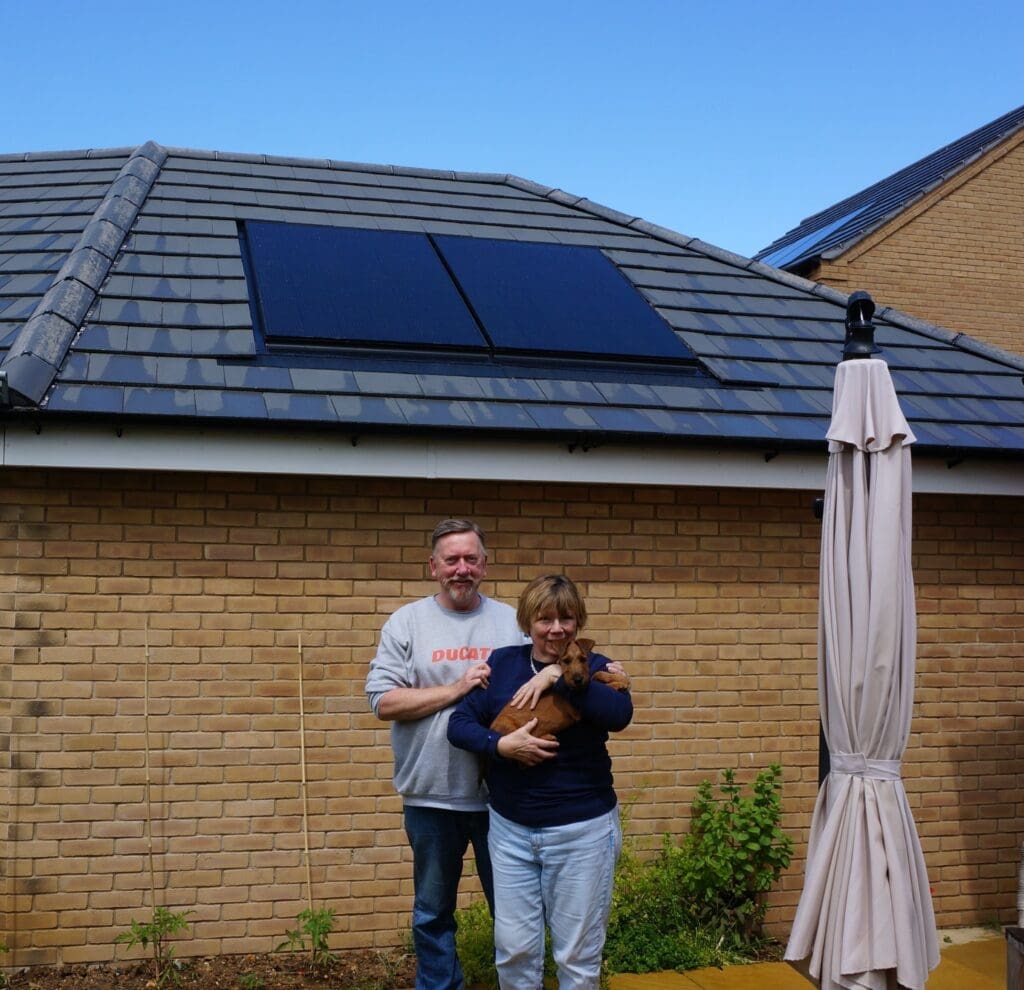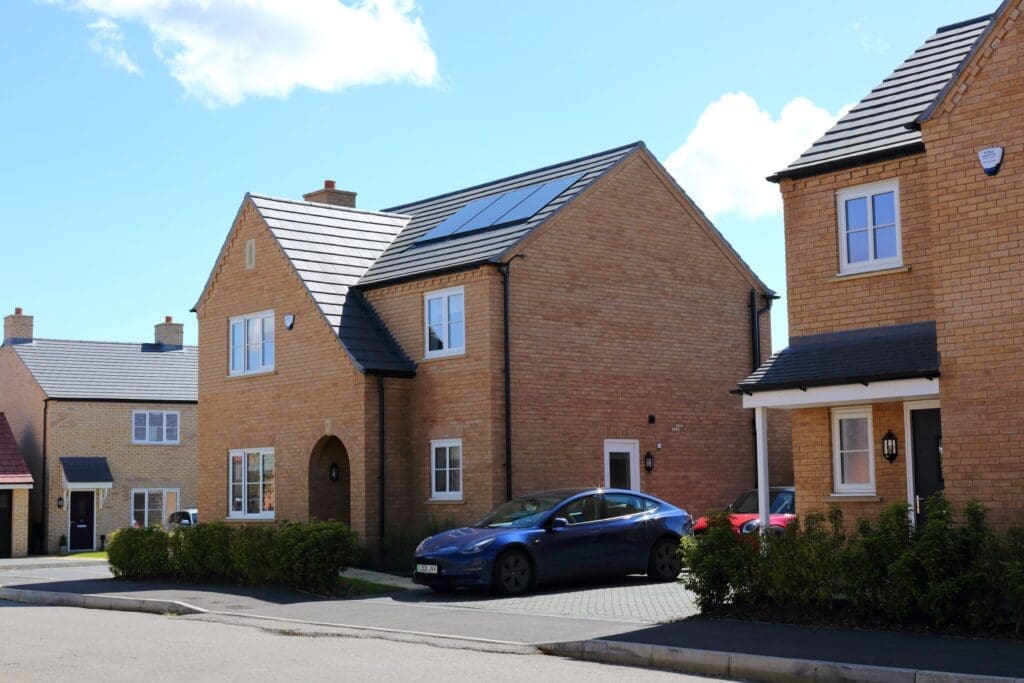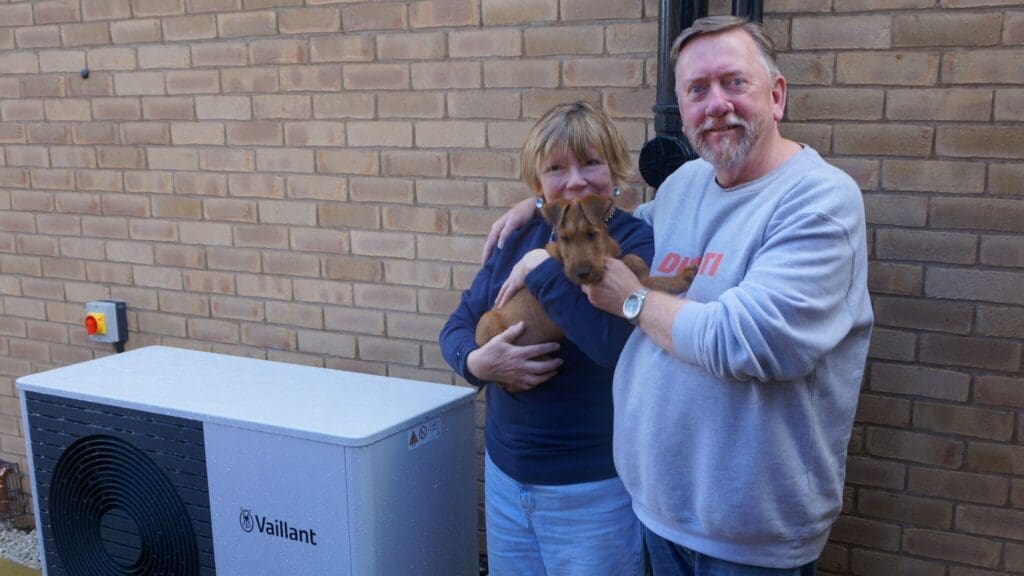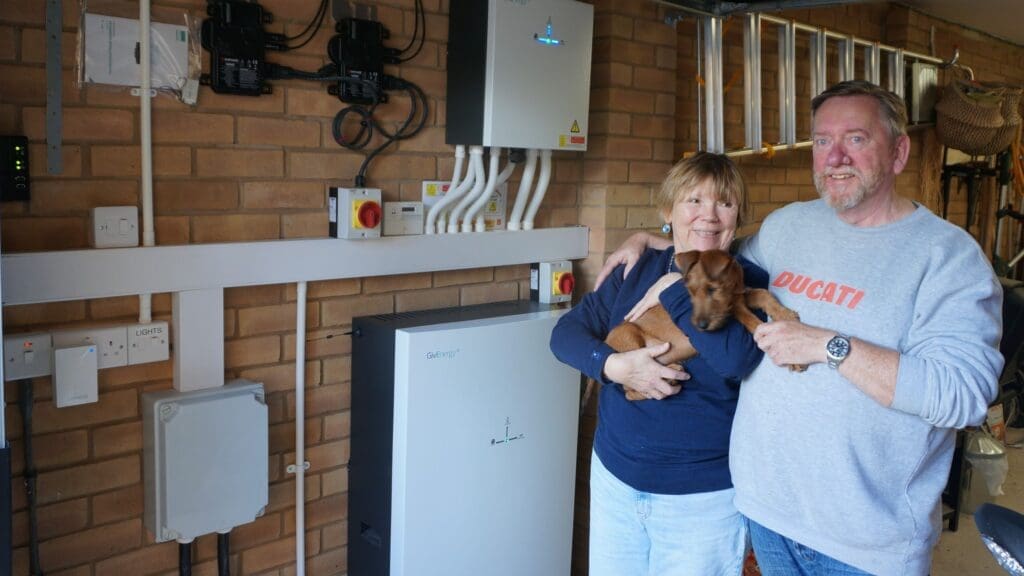
However, one thing their new home wasn’t delivering on was efficiency. It meant that despite having a brand new property, they found themselves upgrading its entire network of pipes to install an air source heat pump, as well as adding several more solar panels and a battery storage system.
You can read their story below, as shared by installer, Brimstone Energy.
How long have you lived in Cambridgeshire?
We moved to Gamlingay in September 2022. We liked the established community, the amenities and the opportunity to buy a new-build house with more space.
We installed an efficient gas boiler at our previous property and always recycled our rubbish. Like most people, we did what we could. Naturally, we liked the efficiency and lower running costs of this new-build house, as well as the bonus of three solar panels on the roof.
What motivated you to start your decarbonisation journey?
We’d found our house and our community. The space just worked… and we had a pub and an Indian restaurant within walking distance. This was home.
However, despite buying off plan from the housebuilder, we were unable to amend any of the specifications of the property. The property came with a nominal 810 Wp solar array and a conventional heating system. Jane was particularly keen to get rid of the gas boiler, so our story began with finding out about Air Source Heat Pumps (ASHP). One thing then led to another, as they say.
We’d struggled to find information about our existing solar panels from the housebuilder. Although we were pleased they were there, we didn’t know how to register them, whether we were exporting electricity, or whether we could get money for doing so. It was all pretty baffling. Jane spoke to our neighbours and discovered we needed to give our energy provider information about our Distribution Network Operator (DNO) and the MCS certificate for the panels. We learned the certificate was needed to register the work to let us ‘sell’ electricity back to the grid.






Mindset shift
What started as a ‘should we?’ became ‘could we?’ over time, before growing into a complete mindset shift. We reached a point where we didn’t just want to do things a bit better, but wanted to do the very best we could.
So where did you begin?
In terms of low-cost energy, replacing gas with the ASHP was important. We became more and more aware of the running costs, inefficiency and environmental impact of our gas boiler. From what we’d read, we knew an ASHP would require more electricity overall. So, if we wanted to become less reliant on the grid, we had to figure out maximising solar panels on our roof. Then, if we were doing the work and putting up scaffolding, it became more cost-effective to explore both sides of our roof and our garage. All this led us onto storage batteries. If we were generating it, we may as well save it.
We decided to go all in.
Did you have concerns about solar panels?
We found it hard to find clear guidance about low-carbon energy. It’s confusing and the information we did find could be conflicting or even negative. I can see this could put people off.
Then there are concerns about aesthetics, wind, weight, and even nesting birds. We installed ‘in roof’ Viridian panels, which removed all these worries. As a nice bonus for us, they were locally sourced and came pretty much down the road from our house.
Where did you research and find information to help?
There’s information out there, but it’s variable. At times, it felt like trying to tie shoelaces with one hand.
Our heating engineer had experience of working with ASHPs, including retrofitting pipework in the house (and making good) to maximise efficiency. It was a big job, but he is Slovakian, and we discovered that Europe are way ahead with fossil fuel free energy. His expertise was invaluable.
We also found some help online and watched lots of videos, but it didn’t seem right that even though we were set on doing the right thing, we had to navigate through the intricacies of it alone. Eventually we came across the GivEnergy website, which then led us to Matt Hilton and Brimstone Energy.
I’m sure this is the story for many… trying to find clarity at the start of a retrofit or energy efficiency project can be hard!
The project – starting at the end
Can you tell us about your system?
We didn’t want to do a half job and regret it down the line. I describe the result now as having moved from 56k dial-up to full fibre broadband internet. We know our energy needs are sorted and future proofed.
Our Vaillant 3.5kW ASHP is installed, we’ve got 11 solar panels, a 13.5kWh GivEnergy All in One Battery and GivEnergy Car Charger. This is all described as the ecosystem – it’s ‘smart’ in switching between battery filling, usage and exporting to the grid… as well as kicking in if there’s a power cut.
The single malt of solar panels
Now, we do get excited about the panels, and not just because they look good. They are monocrystalline, which means they have only one source of silicon…they’re like the single malt of solar panels. They generate nearly double the amount of electricity than others the same size (over 400 Watts peak per panel).
We were then able to pick an energy provider to work alongside all the kit and found the Intelligent Octopus tariff. We’re able to choose when and how we store, use or export our electricity to match with off-peak prices. And then we checked the prices each company pay for energy exported back to the grid using the Smart Export Guarantee (SEG).
So here we are, with no gas, generating our own electricity, an electric car… and a warm home!
Were there any barriers you faced?
For sure. But each of them was overcome with the right attitude and the right team. We’ve talked about the difficulty getting clear information. Since the house had been fitted with a gas boiler, it also came with microbore pipework rather than proper copper piping. This is not uncommon and is a classic case of speed over long-term thinking by the house builder. So, we had a choice about whether to upgrade the pipes in our house to maximise the ASHP. Cue a ‘deep breath’ moment, as the house was new and the plaster fresh.
To maximise the efficiency of the ASHP, we were really left with no choice but to upgrade the entire network of pipes throughout the whole property. Needless to say, this was fairly disruptive, but we were committed to our vision and remaining ‘all in’ with the project. We found a contractor to work with our heating engineer and integrate the GivEnergy ecosystem and panels. Unfortunately, he fell ill in January and was unable to proceed with the project.
So, what happened?
We were committed to the project, so got searching. We needed a contractor who shared our passion for the project and shared our values. We needed a project manager who could oversee the many moving parts of the plan. And… we needed someone who could work alongside the other contractors already involved and pick up the project. Not much to ask at short notice!
Finding Brimstone Energy got the project back off the ground. Again, finding the right company and the right person to work with you is crucial if you want to overcome the barriers you inevitably come across when breaking new ground.
Getting our ducts in a row
Once the team was in place, we were able to get straight to work.
We needed to complete work under the ground first, making sure wiring to the ASHP, battery storage and car charger were in place, ready for the panels. Planning was pivotal in getting our ‘ducts in a row.’
The scaffolding also needed careful thought and planning. From there, the work proceeded at a great pace. I guess efficiency isn’t a surprise for this project, but in just over a week the scaffolding was up, and the panels were in.
There was a standout moment when we needed our drive clear by a certain time. Matt promised he would sort it, and he did by personally ensuring it was clear. Peace of mind comes in the small things when working with contractors.
And now it’s done. How do you feel?
Proud is the word. We did it. We were ambitious, had to swim against the tide a bit, but we’re now in a gas-free house producing our own electricity and running an electric vehicle. We charge our car on a super-cheap rate overnight and run our house off the battery in the day. From a seed to an idea, to a decision, to now. It’s a great feeling.
For 6-8 months of the year, between the Viridian solar panels and the GivEnergy battery, we don’t really import any electricity for the house itself. For the rest of the year, we only require off peak electricity – whether that is storing electricity in the battery or running the heat pump for hot water and heating. We’ve yet to go through our first winter, but we are confident that our bills will remain very low.
There will be lots of people in the position you were in a year ago. What would your advice be?
Genuinely, sustainable, low-cost energy is in reach if you decide to go for it.
- Do enough research to ask people specific questions
- Listen to people who’ve done it, not just what you see on TV
- Start. An ASHP and full system might be too much, but don’t rule out panels and a battery
- Bringing in expertise is crucial for peace of mind. Brimstone Energy did this for us
About Brimstone Energy UK
Matt Hilton, Founder and Director, served for 18 years in the British Army as an officer in the Intelligence Corps before founding Brimstone Energy.
He has always been passionate about the environment and wants to help homeowners take advantage of the green energy revolution.
Credit: Images provided by Brimstone Energy


